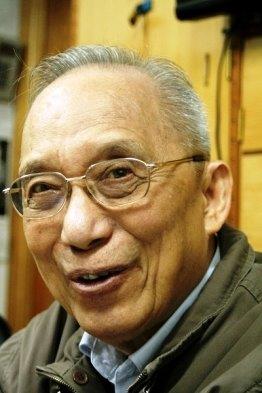It is not often that the Economist reports on Christian matters, still less on evangelical Christians. Yet the death, in August 2013, of Chinese house-church leader Lin Xiangao, better known as Pastor Lamb, merited quite a long obituary in its columns.
Perhaps it was the fact that no less than 30,000 Chinese Christians tried to attend his funeral in Guangzhou which drew their attention!
I knew Pastor Lamb well and have visited him in his house-church many times since the early 1980s. A quiet, unassuming man,

often smiling, it was difficult to take on board that he had done slave labour in dangerous coal mines for 23 years because of his faith in Christ.
The son of a Baptist preacher, he had done theological training in Hong Kong and returned to Guangzhou. At the young age of 22, in 1946, he began his gospel ministry.
Conflict
But, soon after the Communist victory in China in 1949, he came into increasing, if unwilling, conflict with the authorities as they sought to control and even crush the Christian church.
Pastor Lamb was one of a few noble evangelical leaders (Wang Mingdao was the most famous) who dared to defy the government, not because they were not loyal citizens, but because it sought to impose atheistic control on the church through the puppet ‘Three Self Patriotic Movement’, whose then-liberal theology was anathema to Lamb.
On the night of 14 September 1955, Pastor Lamb was arrested and charged as a member of a ‘counter-revolutionary clique’. But the ‘accusation meeting’ orchestrated by the Three Self Patriotic Movement on 27 September was a complete fiasco, as no one in his church was willing to come forward to denounce him, as was the usual communist practice.
Despite this, he disappeared into the notorious Chinese labour-camp system for the next 23 years, apart from a brief spell from January 1957 to May 1958, when he was released.
During that time, he told me, God looked after him. From 1963, he did forced labour in the coal mines in north China. He estimated that, during 15 years, he coupled together some two million coal trucks in the dark tunnels. Many men were killed or seriously injured, but he emerged without a scratch.
‘For 20 years, I could have died many times over. But God protected me and protected my faith. I learnt a lesson from Peter who was proud and denied the Lord three times. So I prayed in fear and trembling and the Lord heard my prayer’. By 1977, he was even recognised as a model worker by the colliery!
Release
On 29 May 1978 Pastor Lamb was finally released and returned to Guangzhou. Alone, he began to witness and teach English (now all the rage) to young people at his original home in Damazhan (Big Horse Lane).
Gradually a house-church was formed, which grew to several hundred members and today attracts some 3000 souls to its Sunday and weekday services. Over the last 20 years, every year, some 300-400 new converts have been baptised in half a dozen annual baptismal services.
All this did not escape the attention of the authorities. Near midnight on 22 February 1990, police rushed upstairs to the meeting-place, confiscated vast amounts of Christian literature and took Pastor Lamb to the police station where he was interrogated. He was released the following day. An official notice was pinned to the door declaring the meeting illegal, and therefore closed down. However, when I visited, a couple of months later, a few brave Christians had crept in to hear Pastor Lamb ‘share’ sitting down (he was forbidden to stand and preach!).
I shall never forget that prayer meeting, as we knelt on the hard wooden floor and the pastor prayed, ‘Oh Lord! We are like the children of Israel at the Red Sea with nowhere to go. Help us, Lord!’
The Lord did answer. A few months later the rain had washed away the official poster. Hundreds of Christians came back and meetings resumed on an even bigger scale. The authorities have ever since turned a blind eye, no doubt also encouraged by the high profile Pastor Lamb had by now gained overseas, particularly in America.
Bag packed
Billy Graham paid him a visit when he came to China. Nevertheless, he always kept his bag packed in the modest room he lived in, at the back of the meeting place — just in case of arrest.
Pastor Lamb was first and foremost a gospel preacher. People in China were (and still are) hungry for the gospel. I remember one sermon I heard him preach in his clear Cantonese, lasting 1 hour and 40 minutes — long even by Chinese house-church standards.
He had his idiosyncrasies. One group of American Presbyterians I took to meet him were aghast at his premillennial prophetic views and penchant for biblical numerology.
He also upset some by denouncing the much-vaunted ‘Back to Jerusalem’ Chinese mission movement as being largely bogus in its early, extremist manifestations overseas.
But this humble servant of God trained a team of younger, full-time gospel workers. They are well able to carry the work forward. The 30,000 Christians who poured out on the streets of Guangzhou to attend his funeral were well aware that an era had passed with his passing.
The older house-church leaders who stood for Christ at so great a cost from the early 1950s to the late 1970s have now largely gone to glory. Pastor Lamb was one of the youngest of this generation.
His younger successors have been well trained. They are well aware that it is because of the living testimony of men and women like Lin Xiangao that, under God, the Chinese church has now grown to over 70 million believers, to become the largest evangelical community in the world.
Tony Lambert
OMF International




